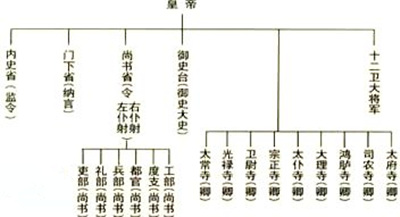Three Departments and Six Ministries
三省六部制
The Three Departments and Six Ministries System was initiated during the Sui Dynasty (581—618).
三省六部制首创于隋朝(581——618),
Subject to some adjustments at different times, the system was employed by subsequent dynasties right up to and including the Qing (1644—1911).
这个制度在之后的朝代包括清朝(1644——1911)都得以应用并根据不同时期做出调整。
During the Sui Dynasty, the three departments were known as the Shangshu, Menxia and Neishi.
隋朝期间,三省指“尚书省”、“门下省”和“内史省”。
The Shangshu Department was in charge of the administrative affairs of the country.
尚书省——负责执行国家的重要政令;
The Neishi Department dealt with the issue of imperial orders.
内史省——负责颁布皇帝的诏令;
The Menxia Department handled the verification of orders and policies.
门下省——负责审核各项政令和决策。
The three boards restricted and oversaw each other.
三个部门互相牵制并监督彼此。
The senior official of each department was equivalent to Zaixiang, namely prime minister.
各个部门的最高官员行使宰相的权力,被称为“纳言”、“内史令”和“尚书令”。

“Six Ministries” referred to the six branches of the Shangshu Department.
六部指尚书省下设的六个部门。
The Ministry of Civil Affairs—responsible for the appointment, training and dismissal of officials.
吏部——负责官员的任免、培训 和解雇;
The Ministry of Rites— responsible for the emperor’s religious obligations and ceremonial, schools, examinations, reception of foreign guests, and selection of officials.
礼部——负责皇帝的宗教事务和庆典、学务、科举、外国宾客的来访以及官员的选拔;
The Ministry of Military Affairs— responsible for the military affairs, such as conscription, training army, declaring war, ordnance, and etc.
兵部——负责军事,比如征兵、练兵、宣战、军械等;
The Ministry of Punishments— responsible for law enforcement and judicature.
刑部——负责法令的颁布与司法;
The Ministry of Finance— responsible for household registration and finance.
户部——负责户籍登记和财政事宜;
The Ministry of Public Works— responsible for building new facilities and bringing wasteland under cultivation.
工部——负责建造新的设施和开垦荒地。
Of these, the Ministry of Civil Affairs ranked highest.
在这些部门中,吏部是最重要的。
The senior secretary of each ministry was called Shangshu and the assistant Shilang.
每部设尚书为最高长官,侍郎为辅助。












